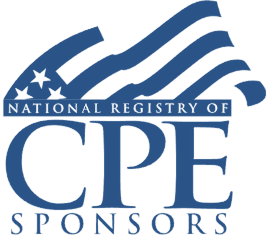Welcome! Save 30% on all CLE, CPE, and Professional Skills webinars, plus 15% off any annual pass with code CYBER2025
About the Course
Introduction
This webinar will focus on the requirements regarding assessing internal control systems for financial statement audit purposes. The panelist will provide a perspective on the need for and benefits of the required assessment and optional testing of internal controls following AICPA generally accepted standards. In addition, the seminar will clarify some of the differences with PCAOB standards.
Description
Two decades have passed since auditing standards were modified to require an assessment of the system of internal controls in response to observed dramatic audit failures and frauds. Since then, the COSO Internal Controls Framework, the basis for AICPA and PCAOB standards, has been updated to provide more structure to the concepts and promote better consistency and effectiveness in identifying material weaknesses in controls. Recently effective, SAS 145, Understanding the Entity and Its Environment and Assessing the Risks of Material Misstatement, has revised AU-C 315 and has updated auditor guidance on completing controls assessments. This seminar will identify these updated requirements and provide insight into efficient and effective compliance.
As a topic with an observed high rate of noncompliance in peer reviews and inspections, this webinar will explore some of those cited deficiencies and the reasons for them and suggest modifications to approaches and working practices to come into compliance. While viewed by some auditors as an unnecessary procedure for non-public entities, this requirement has reduced the incidence of audit failures, lessened litigation, and improved the reliability of business financial reporting. An issue is that the initial push for understanding how the assessment and documentation should be performed has waned, resulting in less training of partners and staff, less familiarity with the requirements and terminology, and more reliance on practice aids to perform the assessment.
Listen as Lynford Graham CPA, Ph.D., CFE emphasizes how SAS 145 affects internal control assessments and offers tips on evaluating these controls as well as for establishing best practices to augment technical guidance.
Presented By

Mr. Graham is a Certified Public Accountant with more than 40 years of public accounting experience in audit practice and in various National Firm policy development groups. He is a consultant on professional auditing and accounting matters and an author. Until ecently Mr. Graham was a Visiting Professor of Accountancy at Bentley University in Waltham MA. He is a frequent speaker at National AICPA and State Society conferences.
-
BARBRI is a NASBA CPE sponsor and this 110-minute webinar is accredited for 2.0 CPE credits.
Date + Time
- event
Monday, October 23, 2023
- schedule
1:00 p.m. ET./10:00 a.m. PT
- Internal controls: an introduction
- Utilizing inherent, control, and analytical procedures to achieve a low risk audit
- Conflicting guidance
- PCAOB
- AICPA
- Uniform Guidance
- The impact of SAS No. 145 (Risk Assessment) on assessing systems of internal control
- The 17 required COSO principles
- Current assessment best practices
- Overcoming frequently faced issues and common peer review comments
The panelist will review these and other key issues:
- Understanding the implications for assessing and/or testing systems of internal control
- Developing best practices for efficiency and compliance when assessing controls
- Identifying key changes required under SAS 145 in the assessment process, including new areas of emphasis in the standard
- Identifying the implications of controls assessment findings and reporting requirements
- Identifying the supportable size of test of controls for financial statement audit purposes
Learning Objectives
After completing this course, you will be able to:
- Identify best practices for assessing and testing systems of internal control
- Determine the supportable size of a sample needed for testing (and relying on) systems of internal control
- Ascertain the implications of deficiencies and material weaknesses identified during the audit
- Increase your understanding of why the required assessments are a benefit to auditors, clients, and the public that auditors serve
- Decide how to determine the supportable size of the test of controls for financial supports
- Field of Study: Auditing
- Level of Knowledge: Intermediate
- Advance Preparation: None
- Teaching Method: Seminar/Lecture
- Delivery Method: Group-Internet (via computer)
- Attendance Monitoring Method: Attendance is monitored electronically via a participant's PIN and through a series of attendance verification prompts displayed throughout the program
- Prerequisite: Three years+ business or public firm experience, preparing reviewed, compiled, and audited financial statements and the relative disclosures. Specific knowledge and understanding of GAAP, SSARS, and peer review policies.

BARBRI, Inc. is registered with the National Association of State Boards of Accountancy (NASBA) as a sponsor of continuing professional education on the National Registry of CPE Sponsors. State boards of Accountancy have final authority on the acceptance of individual courses for CPE Credits. Complaints regarding registered sponsons may be submitted to NASBA through its website: www.nasbaregistry.org.

BARBRI CE webinars-powered by Barbri-are backed by our 100% unconditional money-back guarantee: If you are not satisfied with any of our products, simply let us know and get a full refund. Contact us at 1-800-926-7926 .
Unlimited access to premium CLE courses:
- Annual access
- Available live and on-demand
- Best for attorneys and legal professionals
Unlimited access to premium CPE courses.:
- Annual access
- Available live and on-demand
- Best for CPAs and tax professionals
Unlimited access to premium CLE, CPE, Professional Skills and Practice-Ready courses.:
- Annual access
- Available live and on-demand
- Best for legal, accounting, and tax professionals
Unlimited access to Professional Skills and Practice-Ready courses:
- Annual access
- Available on-demand
- Best for new attorneys
Related Courses

Accounting for Income Taxes ASC 740: OBBBA Implications, Business Combinations, Valuation Allowances
Thursday, February 5, 2026
1:00 p.m. ET./10:00 a.m. PT

Form 990-PF: Meeting IRS Demands for Fiscal, Grant, and Other Data From Private Foundations
Friday, December 12, 2025
1:00 p.m. ET./10:00 a.m. PT

Impact of OBBBA and Recent Legislation on NPOs: Funding Cuts, Deductible Contribution Limits, New Scholarship Credit
Thursday, November 6, 2025
1:00 p.m. ET./10:00 a.m. PT

Identifying Lobbying and Political Activity for Nonprofits: Excluded and Allowed Activities
Thursday, December 4, 2025
1:00 p.m. ET./10:00 a.m. PT
Recommended Resources

Gain a Competitive Edge Through Efficient CPE Strategies
- Learning & Development
- Business & Professional Skills
- Career Advancement


